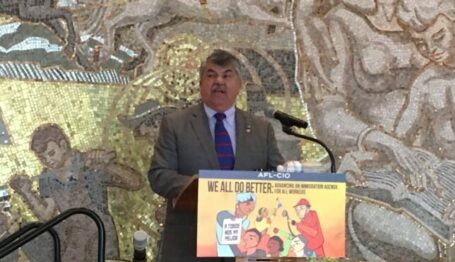Labor Watch
UNIONS WITHOUT ELECTIONS: Only one union member in 17 ever voted to join the union
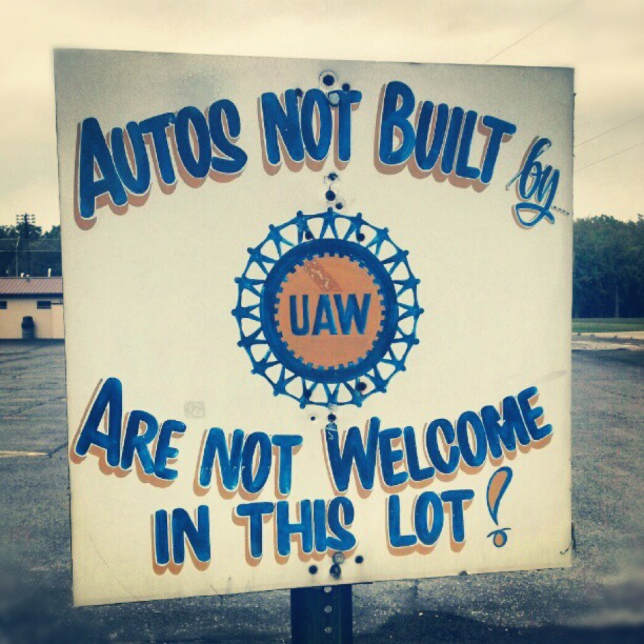 "Autos not built by UAW are not welcome in this lot!" Credit: Adam Schweigert, 2012. License: https://goo.gl/3T6ilQ.
"Autos not built by UAW are not welcome in this lot!" Credit: Adam Schweigert, 2012. License: https://goo.gl/3T6ilQ.

Summary: After working for 50 years a Ford employee never once voted to have representation by his union, the United Auto Workers. How could this be? Unions can exist using the “presumption of majority support.” Unions have “majority support” if they have a majority of all the votes cast, discounting those workers who did not vote. Workers are discouraged from opting out of union representation by a series of obstacles put in place by the unions. This article discusses the various devious ways that unions hold control over companies and workers.
Terry Bowman, an activist profiled in the January 2016 Labor Watch, has worked as an hourly employee for Ford Motor Company in Dearborn, Michigan, for 20 years. Working for Ford is a family tradition. Bowman’s father also worked for Ford, as well as a brother and several aunts and uncles. At Ford, the Bowmans shared something else: representation by the United Auto Workers (UAW).
Bowman was congratulating another Ford employee last summer as the employee retired after 50 years at the company when he realized, with shock, that the employee’s half-century membership in the UAW had never, not a single time, included the chance to vote whether to be a UAW member. That decision was settled an entire generation before he started at Ford, and for the better part of a century, that long-ago choice was binding everyone working at Ford.
In 1941, Ford Motor Company was organized by the UAW, but today no employee from that time remains on the payroll. That means no worker at the firm has ever once voted to be represented by the union. Yet according to the doctrine known as the “presumption of majority support,” the UAW has escaped having to earn workers’ support in a new election for more than seven decades.
And Ford’s workers are not alone. Throughout the country, most members of a union have inherited representation this way with no choice in the matter. That means entire generations of Bowmans and everyone working beside them have had union “representation” thrust upon them. A study from the Heritage Foundation, a think tank in Washington, D.C., has documented just how overwhelmingly pervasive this problem is. Heritage found that nearly all unionized workers in America—94 percent—have never once voted for the union that represents them.
UNELECTED REPRESENTATIVES
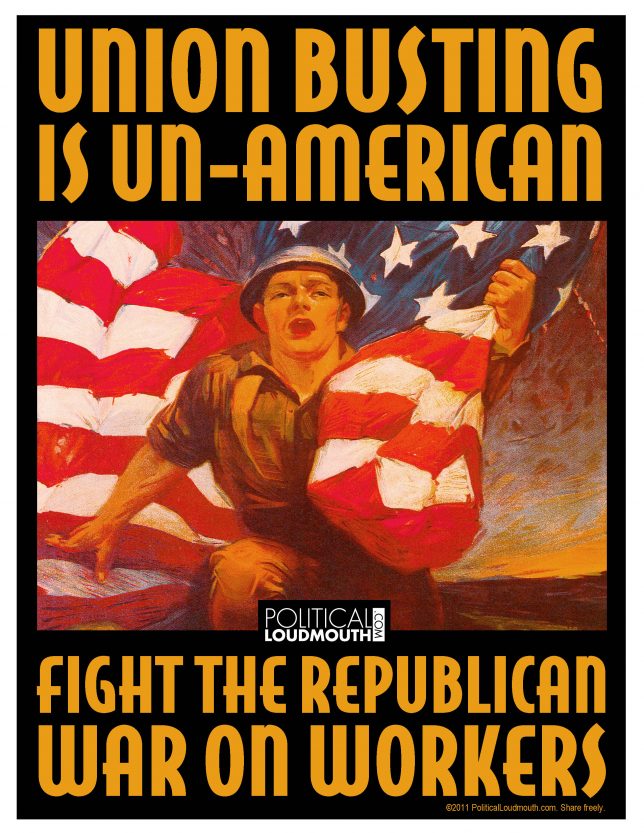
Union-Busting is Un-American. Credit: Political Loudmouth, 2011. License: https://goo.gl/aO9WU9.
When unions represent workers’ interests in negotiations with their employer, the representation is supposedly made legitimate because workers have voted to have union representation. But actually, only about six percent of workers represented by unions that are governed under the National Labor Relations Act (NLRA) have ever voted to be represented by their union. (Most workers are covered under the NLRA; the most significant exceptions are agricultural employees, domestic employees, supervisors, government workers, independent contractors, and some close relatives of individual employers, plus railroad and airline workers whose employment is governed by the Railway Labor Act.)
The NLRA has a preamble that says the law will protect “the exercise by workers of full freedom of association, self-organization, and designation of representatives of their own choosing.” Theoretically, the law defends these legitimate worker freedoms by letting workers elect bargaining representatives democratically. Then an elected union is supposed to negotiate on workers’ behalf with regard to compensation, working conditions, etc. The union is also supposed to be accountable to the workers they represent.
But although the beginning of this federal process for union representation is democratic, the process over time has come to lack any meaningful accountability of unions to the workers they represent. That cannot be denied, when we see only six percent of workers now represented have in fact voted for their union, while two-thirds of workers think union representatives are representing themselves rather than the workers.
To arrive at the six percent figure for workers who have actually voted for union representation, the Heritage Foundation analyzed union election records and Bureau of Labor Statistics data on turnover in unionized companies in order to calculate the number of workers who ever voted for the union now representing them. Heritage found that only 478,000 of eight million unionized workers had ever voted for union representation and remained employed by the company at which they voted. That works out to six percent. The remaining 94 percent of workers are represented by a union they either voted against, or never voted for.
There are four reasons why the current election procedures create this injustice:
- If unions succeed in pressuring a company to drop a secret-ballot election, they can bypass workplace elections completely.
- If a vote occurs, the union only needs to win a majority of votes cast, not the votes of a majority of all workers.
- If a union wins an election, it never has to stand for reelection. Its control continues forever unless a decertification election is held—which is not easy for workers to bring about—and it then loses that election. (Everyone would be horrified if, say, legislatures or governors and presidents had such an unfair arrangement.)
- The official enforcer of federal labor law rules for issues related to collective bargaining, the National Labor Relations Board (NLRB), keeps decertification elections rare by making it hard for workers to bring such elections about, and unions do everything in their power to avoid having to justify themselves through secret ballots.
CARD CHECK
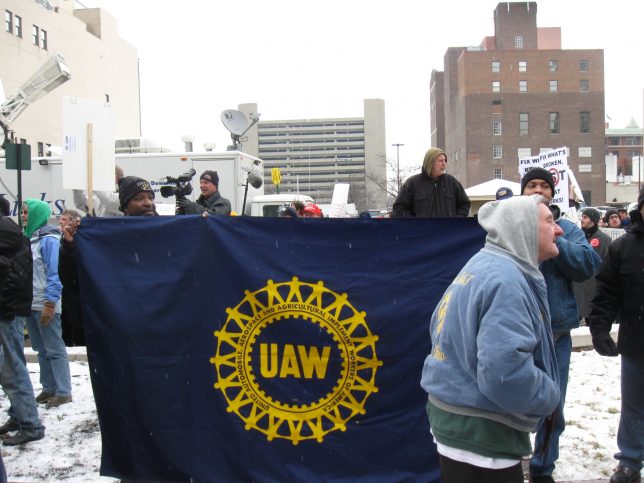
United Auto Workers. Credit: P.T. Manolakos, 2011. License: https://goo.gl/Oghch6.
The NLRA permits but doesn’t demand that employers ask for a secret ballot election to determine whether a particular employer must recognize and bargain with a union. Unfortunately, the U.S. Supreme Court has declared that employers have the right to forego a secret ballot election and recognize a union if a majority of workers sign membership cards. (The name for such an anti-election process is “card check.”) In other words, it isn’t the employees whose wages will have union dues withheld who have the right to demand a secret ballot election; that right legally belongs to the employer.
Naturally, the unions who will live off of workers’ hard-earned dollars prefer to use card check rather than secret ballot elections. Think of it: You’re a union organizer and this morning a worker decides not to sign the card you present; you get to try again tomorrow, and the next day, and the next month, over and over again hoping to force that worker to relent. Sometimes, organizers mislead workers by implying that a signature on the card only means the workers are willing to have an election on the question of union representation. It’s no surprise that if an employer agrees to card check, unions nearly always end up organizing the workers.
Employers usual preference is to have secret ballot elections, but coercing them into card check has become a union specialty. For instance, unions often launch so-called “corporate campaigns” in which they publicly smear a company, hoping to damage its reputation and repel customers. Unions threaten to continue these attacks until the company agrees to forgo a secret ballot. These union campaigns usually succeed, explained UNITE-HERE president Bruce Raynor, because “we’re not businessmen, and at the end of the day, they are. If we’re willing to cost them enough, they’ll give in.”
According to the AFL-CIO, 80 percent of its new members join through card check. Outside estimates suggest the figure is closer to one-third, but clearly, many union members end up in a union without ever having a chance to vote. Lots of them would refuse representation if they had the right to a secret ballot.
This fact was proven yet again in 2014 at a Volkswagen plant in Chattanooga, Tennessee, where the UAW succeeded in having a majority of workers publicly sign union membership cards. After this “card check” victory was announced, Volkswagen then called for a secret ballot election. The company and the union assumed most workers would vote for the union, but a funny thing happened when workers were protected by the privacy of a secret ballot: a majority voted not to join the UAW.
INHERITED UNIONS
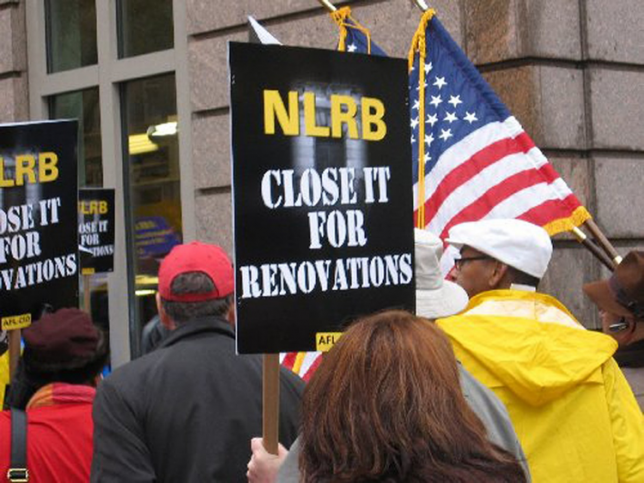
Groups affiliated with the AFL-CIO were picketing the National Labor Relations Board in Washington, D.C.–demanding labor law reform. Credit: Tim Evanson, 2007. License: https://goo.gl/yHSjVy.
Whenever a union gains certification, whether it won that status via the secret ballot or card check, its certification endures—an outcome that contrasts sharply with the classic American understanding of political elections that establish citizens’ representation. Anyone who’s a political representative enjoys that status only for a fixed term. Then, to continue to enjoy his status as a representative, he must regularly win re-elections or lose his mandate.
But union representatives don’t have to face any such test. The NLRB just assumes that the majority of workers support a union unless presented with strong contrary evidence. The “presumption of majority support” gives unions the power to remain certified indefinitely, while the workers paying dues are stuck with little power indeed. Unless they succeed in petitioning for decertification, the union remains in power as their “representative.” And new employees at unionized firms have even less power; they never voted for their supposed representatives and may work their entire career without a chance to vote on whether to continue sending the union a chunk of their paychecks.
MINORITY SUPPORT
Even on the occasion that employers require a secret ballot, unions often take power without ever being chosen by a majority of workers. As it’s written, the law would not seem to allow this. The NLRA declares:
Representatives designated or selected for the purposes of collective bargaining by the majority of the employees in a unit appropriate for such purposes, shall be the exclusive representatives of all the employees in such unit for the purposes of collective bargaining.
But under NLRB regulations “interpreting” the law, unions need only win a majority of workers who vote in an organizing election, whether or not that’s even close to a majority of all workers. Take the case of workers at the LINQ Hotel and Casino in Las Vegas when they voted on August 19, 2015, whether to join the UAW. The union received 74 yea’s, 42 no’s, and 131 workers did not vote. So the UAW took power as the representatives of all the workers, even though fewer than one in three employees actually said they wanted the UAW’s representation.
No wonder our present system allows unions to organize many workplaces where only a minority of employees vote for representation. In fact, a Heritage Foundation analysis of NLRB election records found that, between 2012 and 2015, one in three of all the employees organized in NLRA elections worked in companies where the union had never received support from the majority. If unions had had to enjoy majority support—not just a majority of those voting—it would have cost the union 60,000 dues-paying members.
DIFFICULT TO DECERTIFY
If workers aren’t happy with their union, the law lets them petition for a decertification election that would remove their union representation, but NLRB policies and union practices unite to raise serious obstacles to any decertification vote. First, workers are required to collect signatures from 30 percent of the employees in their bargaining unit. Meanwhile, the NLRB’s “contract bar” doctrine forbids workers from collecting or submitting the needed signatures at any point that a collective bargaining agreement is in place. So workers are left with just one month every three years to ask for a decertification election. Nor may workers collect signatures in any work area or while on the clock.
Needless to say, unions put workers under heavy pressure not to sign or distribute decertification petitions. Most unions will expel a worker if he or she is known to support decertification. Take the UAW constitution, for instance. It calls for expelling any member “affirmatively engaged in efforts to decertify the International Union or any subordinate body thereof.”
Once a worker is expelled from a union, he or she may not vote in elections for union officers or vote on ratifying a new contract. So for all those who sign a decertification petition, it means they will lose what little say they have in the operation of their union—yet if decertification fails, they will still be represented by, and paying dues to, that union.
Such large obstacles to decertification votes make such elections rare. In Fiscal Year 2015, fewer than 10,000 private-sector union members got to vote in a decertification election. Put another way, only 0.1 percent of the eight million workers unionized under the National Labor Relations Act had a chance to decertify their mandated representatives. If you wonder whether that means unions are popular with those whose money they take, consider this fact: In three-fifths of the decertification elections, workers rejected their union representatives. So it’s chilling to realize that the other 99.9 percent of unionized workers didn’t get to vote on their representatives.
LIMITED REPRESENTATIVE ACCOUNTABILITY
The combination of these policies undermines the NLRA’s goal of allowing workers to designate representatives of their own choosing. Workers like Terry Bowman are represented by unions they had no say in selecting. Fully 94 percent of union members are in Bowman’s shoes. They get represented by a union that someone else chose, often decades earlier.
This makes unions less accountable to their members. Workers who want a different union representative—or no union—face considerable difficulty in implementing these preferences. Unions know this, so they feel less pressure to represent their members well. Some unscrupulous unions take advantage of this situation to pursue their institutional interests at the expense of their members.
Consider UNITE-HERE Local 11, which represents hotel workers in California. The local has taken the lead in pushing for higher minimum wages in the California hotel industry. The local has sponsored and passed many local ballot initiatives requiring hotels to pay starting wages exceeding $15 an hour.
That seems fairly typical behavior for any union. But there is a catch. Local 11’s ballot initiatives exempt unionized hotels from having to pay, allowing hotels to pay less than the new minimum—but only if their workforce is unionized. Local 11 has used these exemptions to unionize many California hotels. The union offers to negotiate sub-minimum wages if the hotel management will encourage their workers to unionize. The Los Angeles Times reported that one Local 11 organizer told a former colleague this union exemption “is going to make all the hotels go union.”
These deals are a win-win for the hotel and the union. The hotels have kept their labor costs down by hiring union workers for sub-minimum wages. The union has gotten thousands of new members, all of whom must pay hundreds of dollars in annual union dues. (California does not have a right-to-work law, so dues are mandatory.) Since Local 11 started pushing these ballot initiatives and cutting deals, its dues income has roughly doubled.
But Local 11’s members feel betrayed. One vented to the Los Angeles Times that his sub-minimum pay “really makes me mad. I just wanted to be treated equal. Don’t exempt us, because we’re the ones paying union dues.” Another complained “Why is it more of a benefit to be in a union? The union isn’t really doing anything for us. It’s completely upside-down. They want to pay us less than the minimum wage.”
CONCLUSION
Currently, union representation in the United States is uncomfortably close to that envisioned by dictators who come to power by election but never face the voters again: “One man, one vote, one time.” Or, as Turkish strongman Recep Tayyip Erdoğan reputedly said, democracy is like a bus. “Once you reach your destination, you get off.”
But Americans don’t elect presidents for life. We shouldn’t elect unions for life, or for the lives of people who aren’t even born. As members of the new administration take office, they should a look at ways in which workers can be unshackled from bonds forged by generations past.
David Agnew is a writer in Washington, D.C.



